Affiliate links on Android Authority may earn us a commission. Learn more.
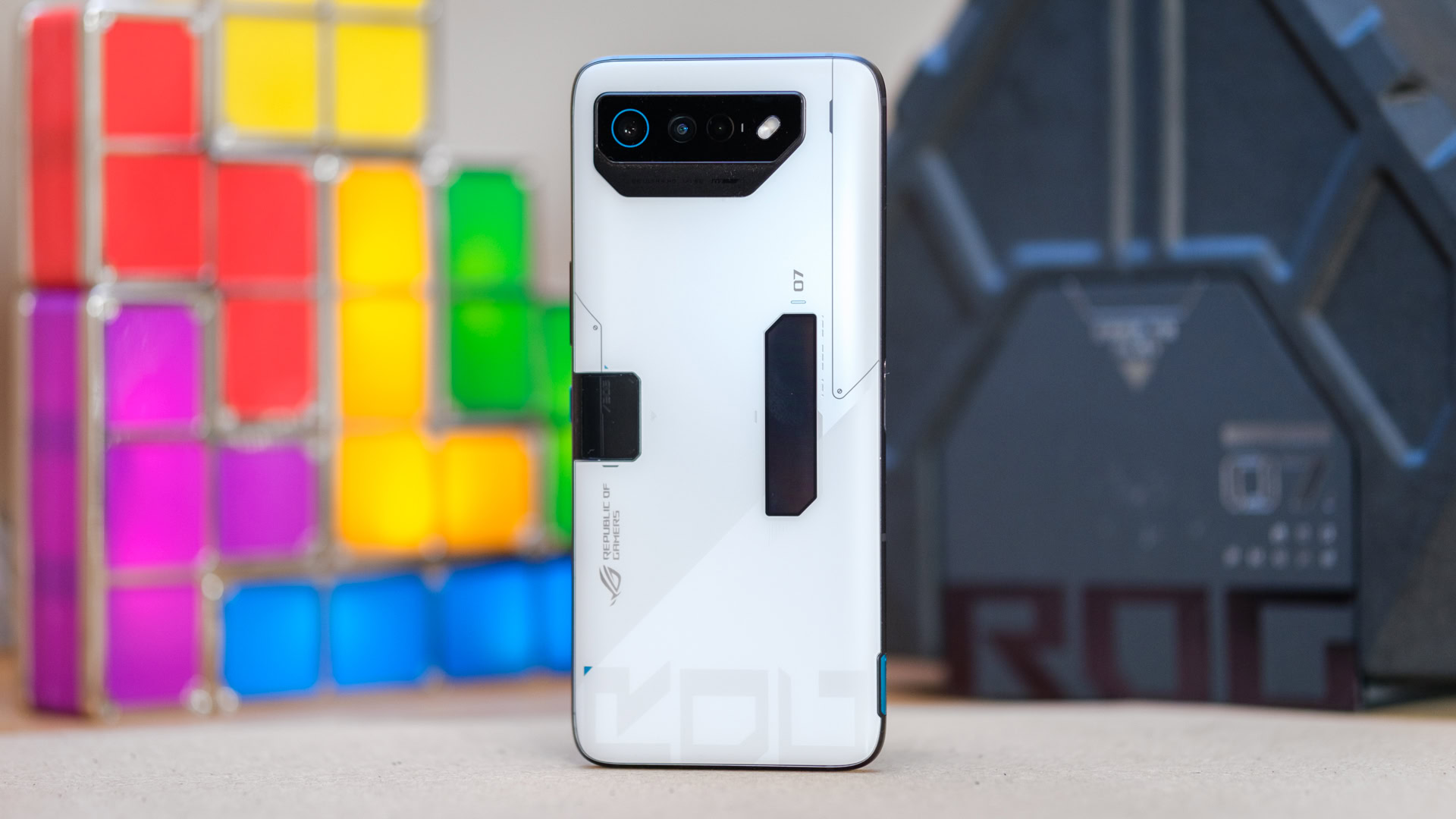

ASUS ROG Phone 7 review: The competitive edge
February 12, 2023

ASUS ROG Phone 7
What we like
What we don't like

ASUS ROG Phone 7
The ROG Phone series is ASUS’ premium gaming phone, complete with associated gaming accessories built to (hopefully) help you boost your W/L ratio. The latest ASUS ROG Phone 7 epitomizes the mobile gaming philosophy, boasting bleeding-edge specifications, RGB lighting, and performance above and beyond your typical flagship phone. Of course, a solid gaming phone has to be a good, well, smartphone too. Is that the case with ASUS’ latest and greatest? Find out in Android Authority’s ASUS ROG Phone 7 review.
Update, February 2023: Added new notes on competitors and the latest ASUS ROG Phone 8 series.
What you need to know about the ASUS ROG Phone 7
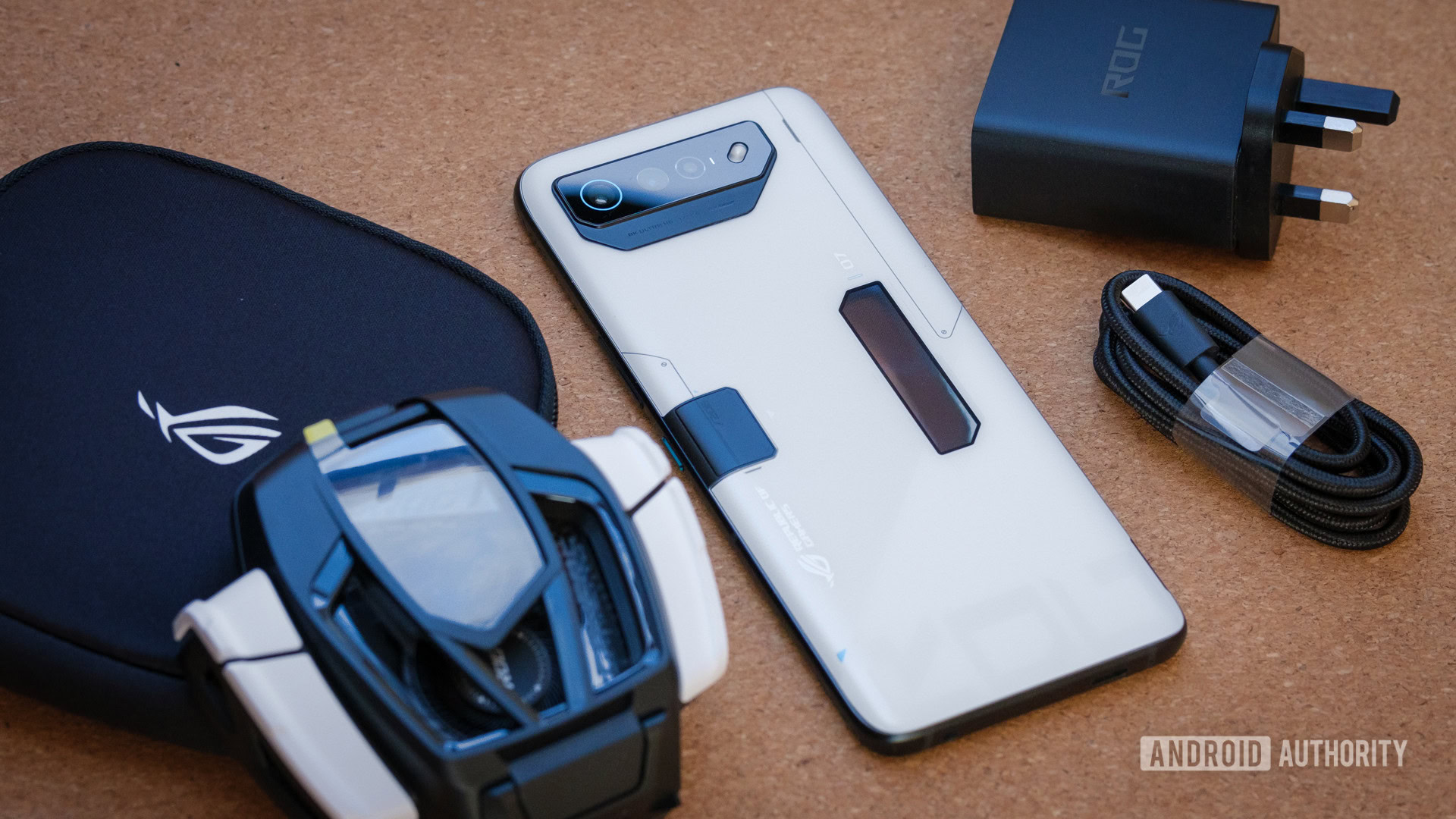
- ASUS ROG Phone 7 (12GB/512GB): $999 / €999
- ASUS ROG Phone 7 (16GB/512GB): $1,199 / £999 / €1,199
- ASUS ROG Phone 7 Ultimate (16GB/512GB): $1,399 / £1,199 / €1,399
For 2023, ASUS has two models on offer: the standard ASUS ROG Phone 7 and the Ultimate edition. The differences are small; the Ultimate has just one memory configuration (16GB LPDDR5X RAM and 512GB UFS 4.0 storage), a customizable ROG Vision external color display, an AeroActive Portal, and comes in a huge crate box with a new AeroActive Cooler 7 accessory (pictured above) included to keep those temperatures down during long gaming sessions. If you already have an AeroActive Cooler 6, don’t worry; the ROG Phone 7 is backwards compatible.
Other ROG series staples remain intact, such as the trusty capacitive Air Triggers that you can use as haptic shoulder bumpers while gaming. It’s also one of the few remaining phones with a 3.5mm headphone jack for wired listening. There’s a jack on the AeroActive Cooler 7 this time around too, which also features a subwoofer speaker for additional bass volume. Two USB-C ports complete the port setup (one on the bottom, another on the left side), allowing you to connect up a charger and other peripherals in either screen orientation, even with the cooler attached. There’s also a passably fast and very accurate in-display fingerprint scanner.
Both models are powered by Qualcomm’s powerhouse Snapdragon 8 Gen 2, boast an IP54 water and dust resistance rating, improved Wi-Fi 7 and 5G sub-6GHz networking, and a new 32MP selfie camera. There are many similarities to the previous generation ASUS ROG Phone 6 Pro too. The design is essentially unchanged, save for the aforementioned AeroActive Portal cooling port on the Ultimate model that opens up (see above) with the AeroActive Cooler 6 or 7 attached. This helps cool the re-shaped graphene sheet inside the phone and is the same setup we saw on the MediaTek-powered ROG Phone 6D Ultimate that was never officially made available in the US.
Elsewhere, there’s a familiar 165Hz 1ms AMOLED display, and the rear camera module relies on the same hardware. However, the camera is augmented with new software in the form of RAW super-resolution zoom and AI image segmentation.
ASUS backs up the ROG Phone 7 with two major OS updates and four years of security updates. That’s an improvement over previous generations but still behind flagship update pledges from the best in the business. Something to keep in mind when spending this kind of money, especially considering how long it typically takes for ROG flagships to receive version upgrades. Case in point: the ROG Phone 6 wasn’t updated to Android 13 until six months after the version’s initial rollout. The ROG Phone 7 is still on 13 at the time of writing, despite the compact ASUS Zenfone 10 moving on up to Android 14, although there is a preview program where a limited number of users can test out Android 14.
The standard ROG Phone 7 comes in two colorways — Phantom Black and Storm White — both with a two-tone matte and gloss “slash” design finish. The ROG Phone 7 Ultimate comes in Matte White exclusively.
The handset went on sale in Taiwan, Hong Kong, and Europe first. The phones are now also available to buy in the US via the ASUS Store and Amazon; retail sales commenced on June 30, 2023.
What’s good?
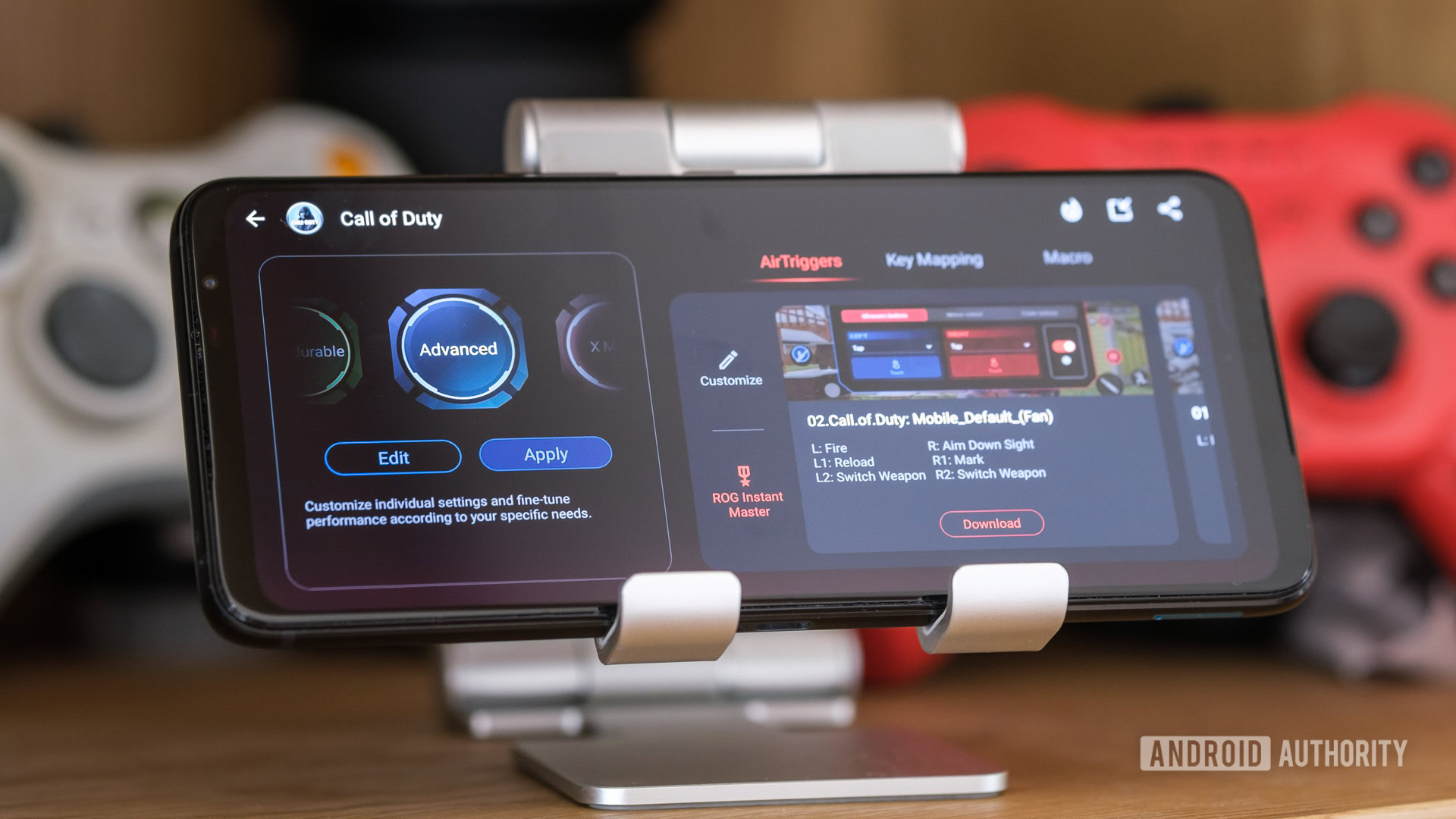
Performance is the big reason to buy a gaming phone, and we will take a detailed look at that in a later section. Suffice it to say this is as powerful a handset as you would expect. The second reason is gaming-oriented software features, which ASUS includes in spades.
Armoury Crate continues to be the go-to location for customizing your accessories and game settings. Here you can enable ROG Vision lighting on the Ultimate version, customize the air triggers, and set up macros for your favorite games. Dive deeper, and you can make per-game performance optimizations, ranging from battery optimized or max performance preferences to display refresh rate and touch sensitivity options.
New Armoury Crate additions include X Sense and X Capture features. X Sense uses AI pattern recognition to alert players to key events happening on screen. Only Arena of Valor in the SEA market is currently supported, but it sounds like a powerful assistant tool and will hopefully be heading to more games. X Capture uses the same technology to record match highlights automatically, again requiring supported titles.
Game optimizations galore help you get ahead of the competition.
A new Vibration Mapping option augments the phone’s bone-rattling haptics, allowing you to map touch-screen button presses to vibrations. Think of it like key mapping for games that don’t offer native controller support, but for touch haptics instead.
The ROG Phone 7 takes this level of customization to the broader UI too as you can pick between the gamer ROG look or classic ZenUI. Taking things further, ASUS now allows the mixing and matching of downloadable theme elements. For instance, you can take the icons from one pack and the wallpaper from another to make the setup your own.
ASUS’ selection of gaming accessories augments the setup further, and they feel very well-built. The Ultimate edition comes bundled with an AeroActive Cooler 7, complete with four wonderfully tactile trigger buttons, RGB lighting, Peltier cooling chip inside, and a subwoofer for the first time. It certainly takes internal and case temperatures down a notch (ASUS claims up to 25°C cooler back panel temps), and the woofer rounds out the sound from the already solid-sounding front-firing speakers. Not only is the phone backwards compatible with the AeroActive Cooler 6, but it also plays nicely with ASUS’ rather nice ROG Kunai Gamepad 3, as well as third-party PS4, Xbox One, Xbox Series X, and even Stadia controllers (RIP).
Speaking of accessories, ASUS ships a 65W charger in the box, which I found to be USB Power Delivery PPS compliant in our testing. This is great; you can use ASUS’ charger to power your other compatible gadgets and even your laptop. Likewise, other USB PD chargers and power banks charge the ROG Phone 7 without issue. ASUS says it should take 42 minutes to full, and we clocked it at 41 minutes when starting at 2%. That’s really fast for a huge 6,000mAh battery.
What’s not so good?
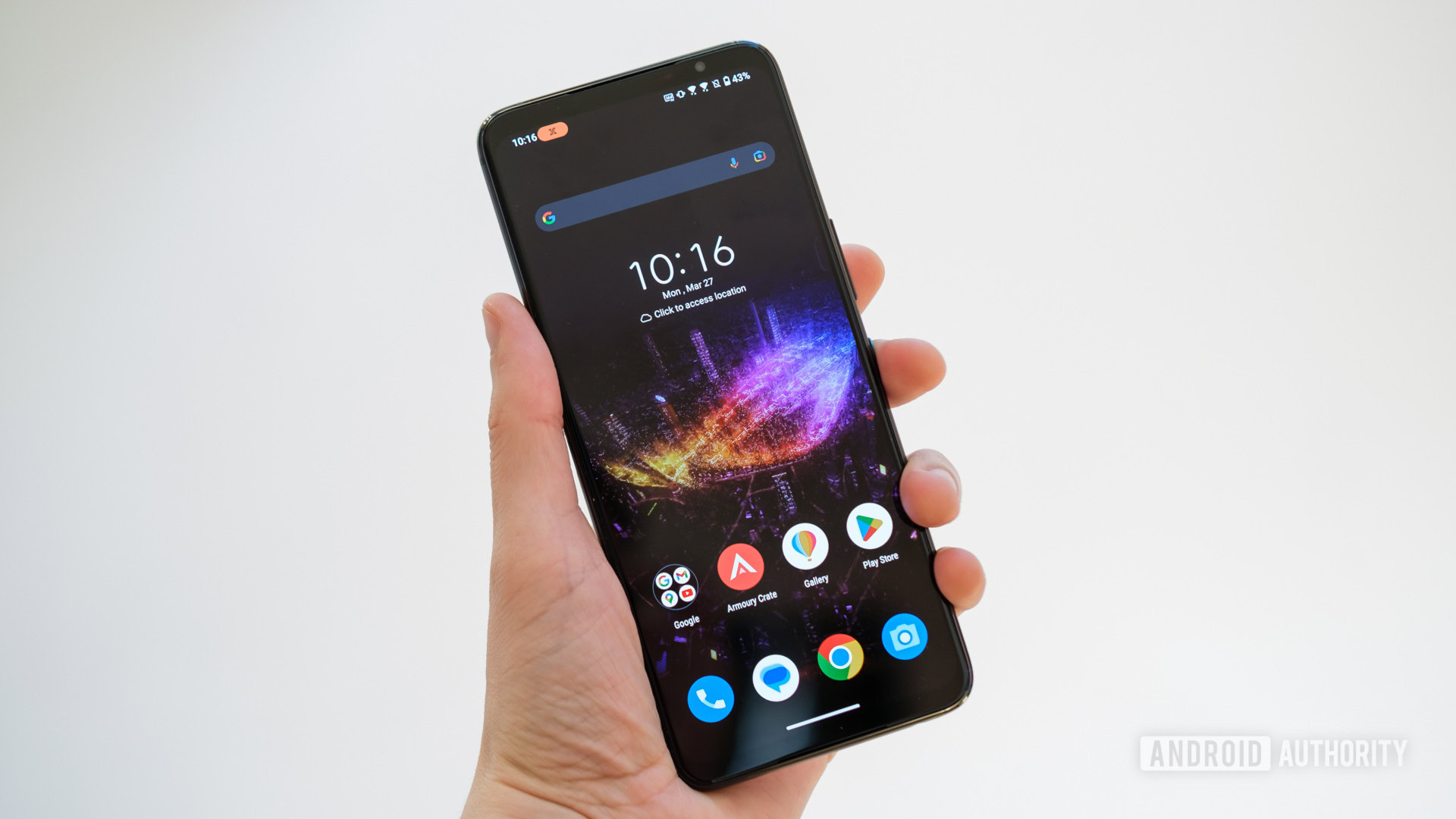
My only real gripe about the phone is the similarities to the ROG Phone 6 series. The design, for instance, has been tweaked with a few less gaudy slogans, but it’s not meaningfully different. In fact, the whole range has looked pretty similar since the ROG Phone 5 family. There’s the same camera hardware (more on that later), Gorilla Glass Victus protection, and Air Trigger system as before. This isn’t strictly bad; the hardware is still rock solid, but it does make it harder to recommend an upgrade over previous models when the formula hasn’t moved on beyond performance (we’ll get to that too).
Having spent some time gaming on it and using it as my daily driver, I’m not sure I see the need for the Ultimate edition either; it offers no additional performance benefits over the base model other than the included cooler and the cooling flap system, which, as we’ll see, isn’t essential. Perhaps the ROG Vision display isn’t for me; preset and even fully custom animations on the back when the phone is charging, playing a game, or receiving a call, hardly seem necessary when the phone has a more customizable and useful always-on-display setting. $400/€400 is a big price hike over the standard ROG Phone 7, and I do not see an equivalent value increase here.
A faster chipset is the biggest reason to upgrade to the ASUS ROG Phone 7.
Gaming phones have other priorities than photography, and that’s certainly the case with the ROG Phone 7. Selfie snapper aside, it’s the same hardware as 2022’s uninspiring setup. ASUS has revamped the package with RAW-domain super-resolution zoom and Qualcomm’s image segmentation technologies. You can see a selection of full-res image snaps in this Google Drive folder.
White balance and exposure are generally solid, colors are punchy when you want them, and there are no obvious noise issues. However, you can spot some HDR blurring artifacts, and subjects can be underexposed with bright backlighting. Equally, low lighting continues to be a point of weakness, particularly for the ultrawide lens. On the positive side, RAW-domain zoom does help, with images at 2x and 3x snaps looking reasonably OK in good lighting. At least sometimes, 4x and beyond are a no-go here.
The macro lens is pretty useless, though. The main lens focuses reasonably close anyway, so the package wouldn’t lose anything with its omission. All in all, it is a functional camera, but certainly nothing exceptional here. Upgrading the selfie camera has yielded mixed results. There’s decent detail and exposure, but the images are a little heavy on contrast. Trickier lighting produces washed-out colors and some blurrier details.
Again, you don’t buy a gaming phone for a killer camera package, but while it’s OK in a pinch, it is ultimately below par for the price ASUS is charging.
The final drawback is ASUS’ middling update commitment. Four years of security patches are good, but just two OS upgrades are poor at this price. Perhaps gamers trade up their phones more regularly? But the value-for-money proposition isn’t amazing if you plan to keep this phone for four years or more.
ASUS ROG Phone 7 benchmarks and gaming tests
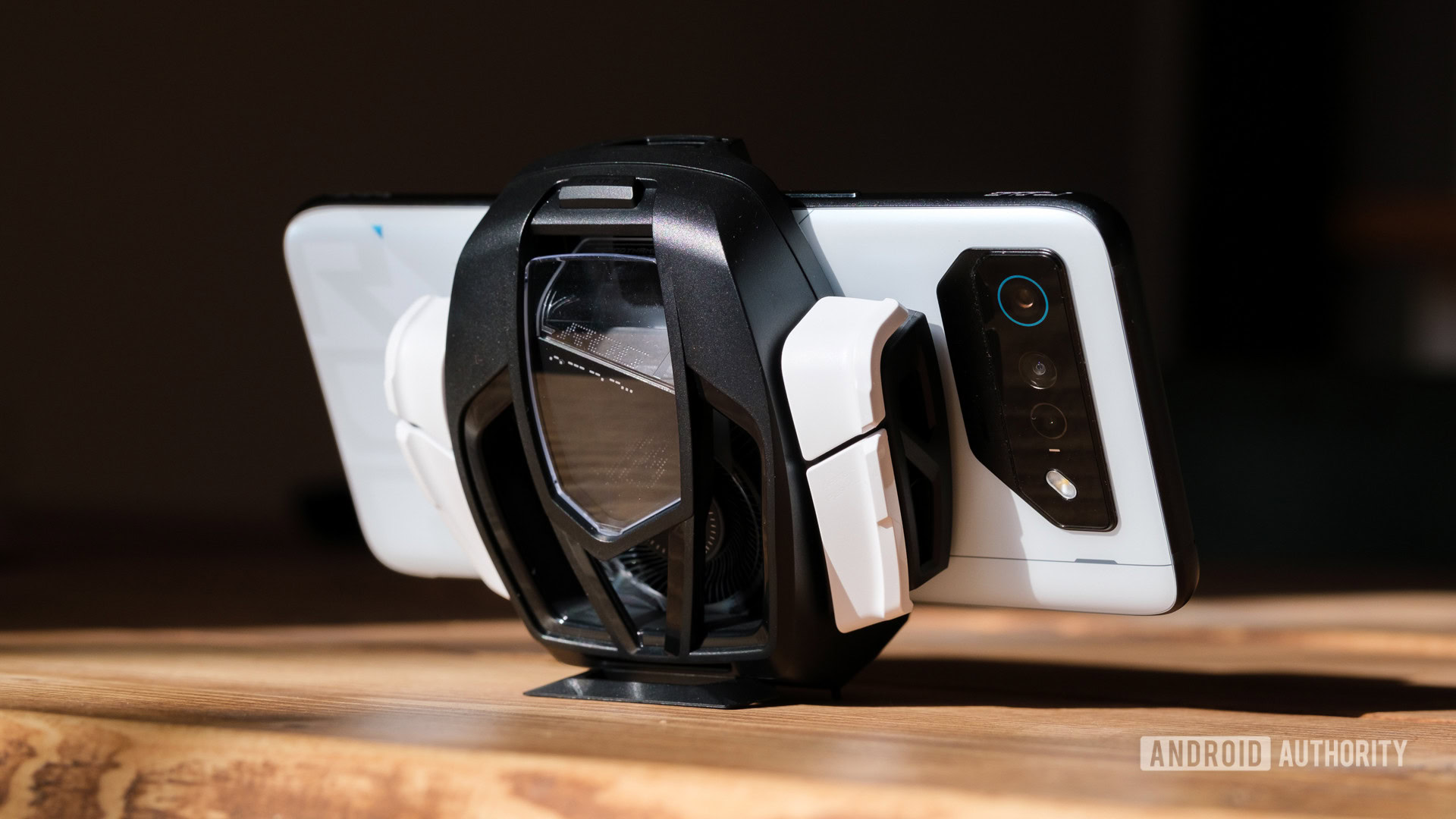
To stand out, a gaming phone needs to offer exceptional performance, and the ASUS ROG Phone 7 certainly delivers. In fact, it’s the fastest Snapdragon 8 Gen 2 smartphone we’ve clocked so far, thanks to ASUS’ X-Mode options for extra performance. We didn’t use the AeroActive Cooler 7 in any of the tests below.
The handset glides through Geekbench 6, PCMark 3.0, and 3DMark’s graphics benchmarks with flying colors. There is quite a difference between X-Mode disabled and enabled. Still, that ensures healthy optimizations for robust battery life during everyday use and maximum gaming performance when you want it. The huge 6,000mAh battery easily takes you through a full day and often two of general use. Gaming time varies, especially when using the AeroActive Cooler, but I extrapolated five hours or more of continuous PUBG Mobile with X-Mode enabled.
This is equally reflected in our extreme graphics stress test. The ROG Phone 7 eventually throttles back performance by default, but X-Mode pushes on for sustainable performance that eclipses the capabilities of regular flagship phones, far surpassing the overclocked Samsung Galaxy S23 Ultra with its Snapdragon for Galaxy version of the Snapdragon 8 Gen 2. The implication is that you won’t have to worry about dropped frames, even when cranking up the graphics and frame rates for a full-on gaming marathon. The trade-off, however, is much higher temperatures.
To put that to the test, I ran through a handful of demanding games while logging frame rate data over 30-minute sessions using X-Mode and no external cooler. ASUS states that you should only need its AeroActive Cooler for sessions lasting an hour or longer. The graph below plots the minimum, maximum, and average frames for each second of gameplay. Ideally, we want to see minimal variation.
Again, the results are impressive. With the graphics cranked up, we achieved a virtual rock-solid 60fps on Call of Duty Mobile and PUBG Mobile. Gaming feels silky smooth, and, most importantly, there are no janks during important match moments. The only stutters I saw occurred during map loading and at the match end, which is common. With frame rates locked for a solid 30 minutes, the phone can clearly handle extended play sessions of some of the best Android games tailored to competitive play.
We stressed the phone with F-Zero GX running at 1080p in the Dolphin emulator. Frame rates are more variable here, as emulation pushes the CPU and GPU hardware more than native Android games. There were many more janks during stage loading phases, as is common with emulators, but we also saw a more inconsistent frame rate as we approached the end of the session. Throwing the cooler on would help keep the emulator running smoother for longer, but this is still a solid effort that still results in smooth gameplay.
Even without the AeroActive Cooler, performance is rock solid across the most demanding Android games.
The only performance drawback is that not all games support frame rates above 60fps, meaning the ROG Phone 7’s 165Hz display isn’t strictly necessary here. Armoury Crate can help you find 165Hz games, which do feel even smoother to play. My only complaint is that the phone is rather bulky for long gaming sessions. Flipping the cooler’s kickstand and connecting the ROG Kunai Gamepad 3 ($129 at Amazon) is the best way to play.
The bottom line is the ASUS ROG Phone 7 provides solid performance for Android games as well as emulation. The addition of hardware-level ray tracing inside the Snapdragon 8 Gen 2 also offers a level of futureproofing for upcoming high-end mobile games. That said, more powerful Snapdragon 8 Gen 3-powered phones are now on the market, including ASUS’ own ROG Phone 8 series ($1099 at Amazon). While the ROG Phone 7 is still very good for gaming, customers demanding absolute peak performance will want to look at newer models.
ASUS ROG Phone 7 specs
| ASUS ROG Phone 7 | |
|---|---|
Display | 6.78-inch Dynamic AMOLED FHD+ resolution (2,448 x 1,080) 20.4:9 aspect ratio 165Hz refresh rate (60, 90, 120, 144, 165Hz modes) 23ms touch latency 720Hz touch sampling |
Processor | Snapdragon 8 Gen 2 |
RAM | 12GB or 16GB LPDDR5X |
Storage | 512GB UFS4.0 No microSD card support |
Power | 6,000mAh battery 65W wired charging Charger in box |
Cameras | Rear: - 50MP wide main sensor (f/1.9, PDAF) - 13MP ultrawide (f/2.2) - 8MP macro Front: - 32MP wide |
Software | ROG UI / Zen UI Android 13 2 Android updates 4 years of security updates |
IP rating | IP54 certified |
Biometrics | In-display fingerprint scanner |
Dimensions | 173.0 x 77.0 x 10.3 mm |
Weight | 239g |
Materials | Gorilla Glass Victus front |
Colors | Phantom Black, Storm White |
ASUS ROG Phone 7 review: The verdict
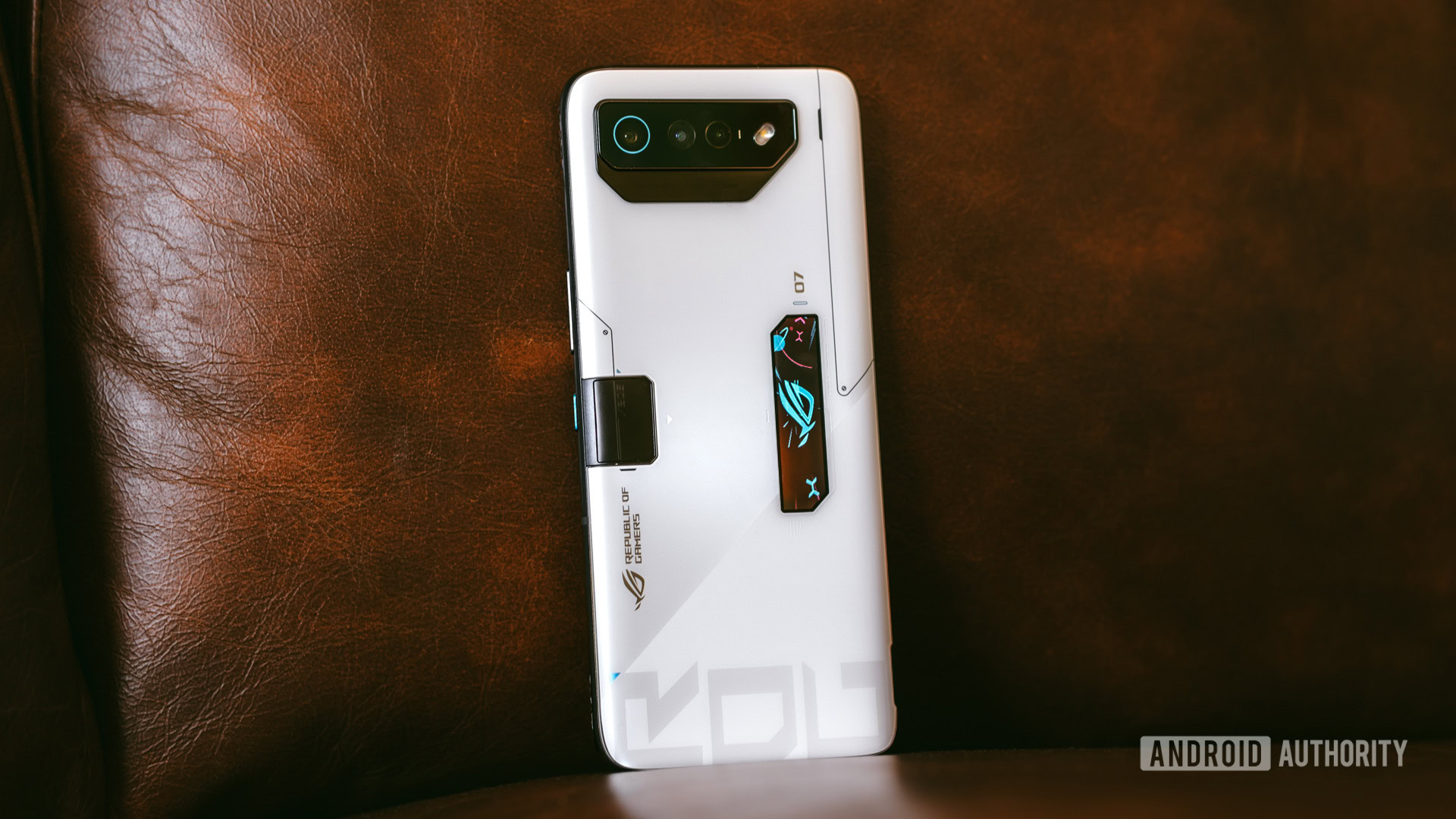
The ASUS ROG Phone 7 is a specialist operator for serious mobile gamers searching for that extra competitive edge. Super stable performance, robust game customization options, and a host of rock-solid accessories elevate the experience far above your “regular” smartphone and help make a case for the continuation of the ROG series. It’s undoubtedly an option we’re happy to recommend to competitive mobile gamers in particular.
That said, we were even more impressed in our ASUS ROG Phone 8 review, which takes the series in a slightly more mainstream direction with a new design, better cameras, and wireless charging. ROG series fans should check out this new model, especially as it’s priced similarly to the 7 series.
One of the few remaining gaming phone alternatives packing equivalent processing hardware is the REDMAGIC 8 Pro ($769 at Amazon). It also packs a Snapdragon 8 Gen 2 processor, up to 512GB UFS 4.0 storage, and a huge 6,000mAh battery. It boasts competitive features like a 960Hz touch sample rate, LPDDR5X memory, a built-in cooling fan, capacitive shoulder triggers, and robust audio features, all at a far lower price. The newer REDMAGIC 8S Pro Plus ($999 at Giztop) steps things up further with a higher-clocked processor, 24GB RAM, and 1TB storage, or there’s the REDMAGIC 9 Pro with a Snapdragon 8 Gen 3. ASUS has the edge in software and extra features, though.
The ASUS ROG Phone 7 is a specialist operator for the serious mobile gamer.
Starting at $999, there’s no getting around the fact that the ASUS ROG Phone 7 is expensive. You can grab a Samsung Galaxy S24 Plus ($1119.99 at Amazon) for a similar price. The Galaxy S24 Ultra ($1419.99 at Amazon) is a little more than the top-tier ROG Phone 7 Ultimate ($1,199) now retails for, but is probably worth the extra cash. Either provides a more well-rounded flagship experience, particularly in the camera and features department, which includes an IP68 rating and wireless charging. These phones also pack solid processing hardware and offer decent gaming performance alongside a Game Launcher suite and big batteries for all but the heaviest gamers.
Gamers should probably also watch Apple’s ever-improving gaming ecosystem. The iPhone 15 Pro ($999 at Amazon) is a solid allrounder, and its A16 Pro processor is a powerhouse when paired with Apple Arcade. But this generation’s addition of a small selection of older AAA console ports, which includes Resident Evil Village for iOS, makes the platform that much more appealing for really serious gamers.
Of course, the ASUS ROG Phone 7 is built specifically for gamers who will make the most of the phone’s robust cooling, gamer-centric software, and novel ideas like AI-assistance X Sense. If you’re more of a casual player, you can save significant cash and pick up a better general-purpose phone for far less.
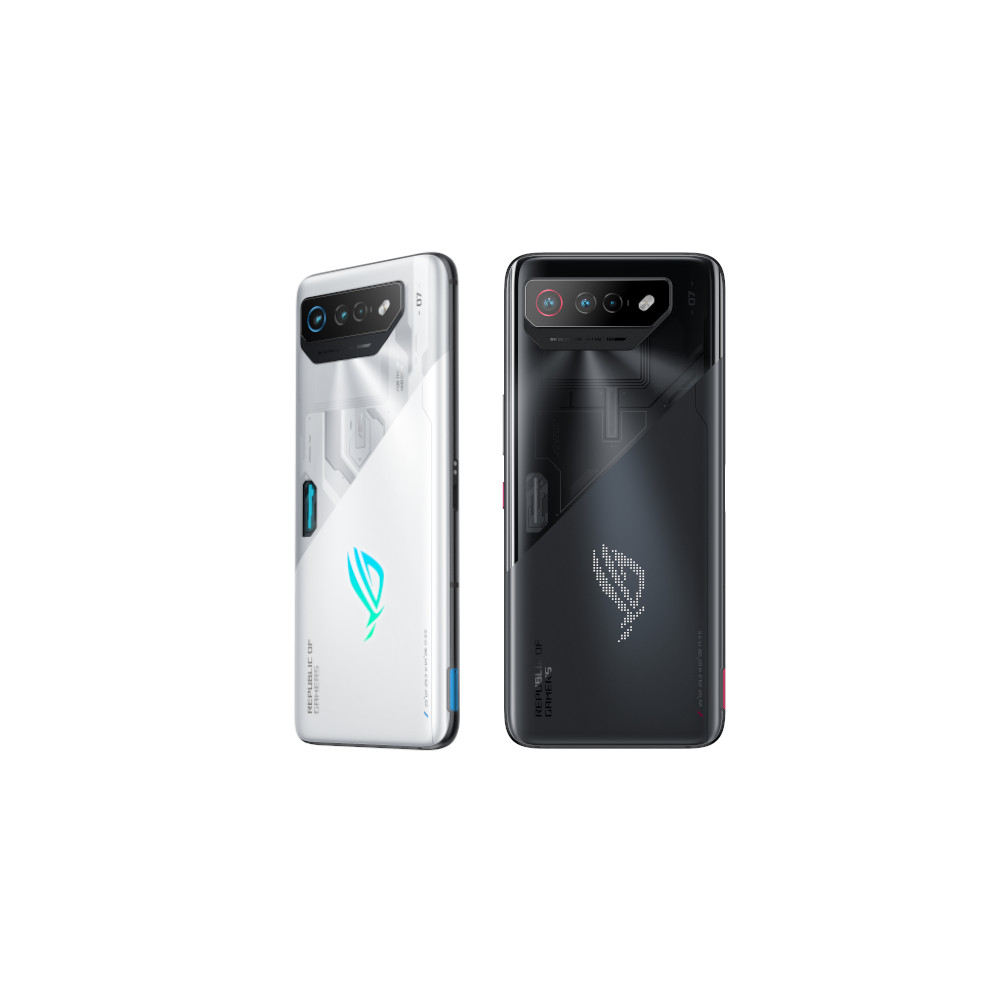



Top ASUS ROG Phone 7 questions and answers
The ROG Phone 7 series has an IP54 rating for dust and splash protection, but not immersion.
No. The ROG Phone 7 trades off wireless charging to support its AeroActive Cooler accessory that attaches to the back of the phone.
ASUS has yet to announce a US launch, but based on previous ROG Phone releases, it should arrive in North America later in 2023.
Yes, the ROG Phone 7 and 7 Ultimate have a 3.5mm headphone jack for wired audio. The AeroActive Cooler 7 accessory now also has a headphone jack located on the bottom.
Yes, the ROG Phone 7 supports 5G networks that use sub-6GHz bands. There’s no support for mmWave 5G.
The ASUS ROG Phone 7 Ultimate is worth buying if you want the very best gaming phone of 2023 and ASUS’ cooling accessory. Otherwise, the standard ASUS ROG Phone 7 nets you the same excellent gaming performance for a little less cash.